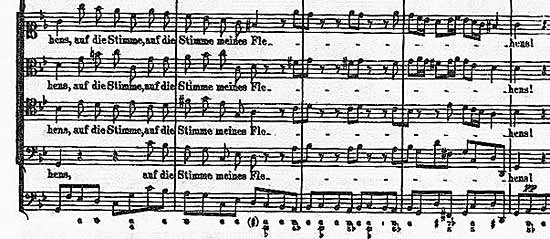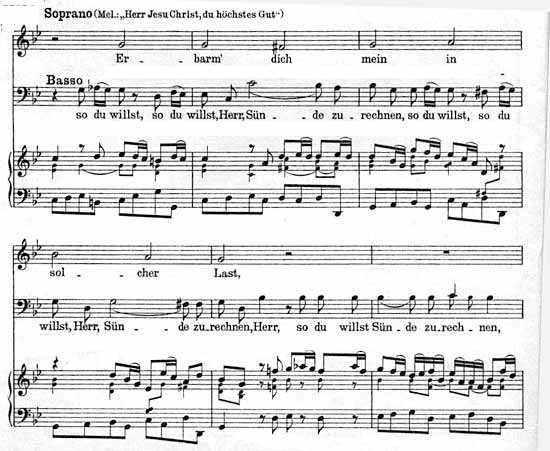There is considerable belief among musicologists that this may be Bach’s earliest cantata. It is not, however, the earliest composition by Bach to survive in autograph (some instrumental works predate even this one). But this is the earliest major work by Bach to survive in manuscript. There are numerous clues to its early origin:
- A postscript on the final page of the manuscript indicates it was written while Bach was organist at St. Blasius’s church in Mühlhausen. Interestingly enough, however, the postscript indicates that the work was commissioned by the pastor at Marienkirche, also in Mühlhausen, but not the church with which Bach was affiliated.
- Its text indicates that it may have been performed for an event of mourning – a major fire in Mühlhausen in May 1707 reportedly destroyed about a quarter of the town, and this work could have been intended for a memorial service commemorating the fire and those lost. The memorial service was held at Marienkirche.
- Handwriting examples from Bach’s early works indicate a smaller more delicate hand than found in works of Weimar or later.
- Bach sets the score using “double tonality”, meaning that some instrumental parts are written in different keys, something not seen in his Leipzig works (here, the oboe and bassoon are written in a minor, while the strings, voices, and continuo are marked in g minor).
- Bach also employs a more conservative, older fashion of canceling out sharps with flats, rather than with natural signs.
The cantata draws its text from two different sources, one of which is the entirety of Psalm 130. Two other movements use text from the chorale “Herr Jesu Christ, du höchstes Gut”. Only in one movement (the bass aria) do the two texts come together.
The cantata is scored for oboe, violin, viola, bassoon, SATB choir, SATB soloists, and continuo.
The individual movements can be difficult to distinguish in this cantata, as the resolution of one cadence is at the same time the start of the next movement, or at least the next distinct section. Despite the difficulty in discerning individual movements, Stephen Daw [The Music of Johann Sebastian Bach: The Choral Works (Madision, NJ: Fairleigh Dickinson University Press, 1981)] demonstrates that this work is symmetrical in form:
Chorus in two sections:
adagio introduction, etc.
vivace choral fugueChorale commentary
bass aria set against soprano chorale line; continuo accompanimentChorus, again in two sections:
brief Adagio
fugal Largo: significant instrumental workChorale commentary
tenor aria, set against alto chorale lineChorus in two sections
Adagio in rhetorical motet style
Allegro in fugal style, with some essential use of the instruments
Like Cantata 71, this was written in Mühlhausen while Bach served as organist at St. Blasius’s church. Unlike in that cantata, however, Bach rarely uses the organ in any role other than as part of the continuo group here.
Perhaps as a reflection of the first line of text, the vocal lines lie rather low in the opening movement. The altos really get to sound like contraltos rather than mezzo sopranos – better still, one of the bass notes actually goes down to the C two octaves below middle C. (Few basses today can hit this pitch, which is fortunately carried in the continuo.) Is this opening a choral version of a French overture? It is written in two clear sections:
| Adagio | Vivace |
| 3/4 | 4/4 |
| “Aus der Tiefe ruf’ ich, Herr, zu dir.” (Out of the depths I cry, Lord, to you.) | “Herr, höre meine Stimme, lass deine Ohren merken auf die Stimme meines Flehens.” (Lord, O hear my calling, incline your ear unto my voice and hear my prayers.) |
| Some use of dotted eighth-sixteenth rhythms, trills at cadences | Mostly continuous eighths, no additional ornamentation; fugal in texture |
| Short phrases | Longer phrases |
| Low range overall | Wider range in general, though definitely higher than the first section |
| Mood is somber | Despite minor key, the tempo and motion lend a more hopeful mood |
Bach sets the text of the second section in a mostly syllabic fashion, except for the word “Flehens” (prayers). The two syllables of this word are separated at a minimum by a short rest, followed by a large leap (often a dissonant diminished seventh interval); in the opposite extreme, the first syllable sounds over an extended, twisting run of eighths (sometimes with trills or other ornaments). This gives the word a special place in this section. Clearly the prayers to God are the focus of this section; the stumbling effect created by the inserted rest, the twisting lines, and the dissonant leaps are an indication that God has not yet responded to the prayers – indeed, the text and tone indicate that the singers are still pleading to God to listen.


The second movement is a bass aria, in which the soloist addresses the Lord while the sopranos of the choir join with the chorale melody “Herr Jesus Christ, du höchstes Gut”. The calm, slowly moving chorale line, limited in range, with even, clearly delineated phrases, provides a stark contrast with the pleading, anxious bass line, wide in range, with a variety of rhythms, and numerous ornaments.

It is almost as if the singer is pleading a prayer to the Lord, but in his focused effort to be heard, he fails to hear the Lord’s calm, quiet response. Bach once again employs limited word painting here near the end of this movement, with repeated undulating melismas at “dass man dich fürchte” (that we may fear Thee) – clearly, man is trembling as he dares to approach the Lord with his prayers.

The next movement begins unusually, with a strong chordal statement by the choir, “Ich harre des Herrn” (I wait for the Lord). The deliberate statement is repeated three times – we are well aware of the symbolism of three for Bach – with a flourish between the statement, first by the altos, then by the tenors. Note that the entire choir sings in the first person singular (I) rather than plural (we), yet does so in rhythmic unison, an indication that even individual needs are heard collectively by God. What follows is a somber fugue. Steven Daw makes the following observation about this motet-like section (“meine Seele harret”):
The yearning and waiting elements are expressed through the sighing vocal suspensions in prolonged chains of chords of the seventh; the delicate patterns of the accompanying oboe and violin lines emphasise [sic] the passage of time, partly because their figures are designed on an altogether quicker time-scale (2/5 or 1/4, effectively, as opposed to the vocal 4/4), partly because the steady rocking figures which they weave so attractively are probably written to sound like the mechanism of a clock: if this is so, it is the first of a number of instances of clock-effects within Bach’s music.
I know nothing of these “clock effects”, but I can show you what Daw means in the score below:

In the subsequent movement, another aria with chorale, the tenor soloist retains the focus on “meine Seele”, this time with more lilt than in the previous movement. Once again, the chorale “Herr Jesu Christ, du höchstes Gut” is sung quietly in the background; in this guise, however, it is sung by the altos, and there are much greater stretches between phrases of the chorale melody. Here, “meine Seele” longs, with a lengthly melisma on each statement of the “wartet” (longs). Later word painting occurs near the conclusion of the movement with the gradual rise in the tenor line as morning breaks – the rise of the tenor line is the rise of the sun.
The final movement is another chorus, which like the previous chorus begins with three strong, chordal statements in rhythmic unison: “Israel, Israel, Israel.” A new texture develops, one with simultaneous independent lines on “hoffe auf den Herrn” (trust in the Lord); another homophonic passage emerges, which begins to fragment rhythmically until the final fugue emerges in full. This fugue features a subject which begins with a descant, then an undulating scalar passage; a contrasting counter subject appears shortly thereafter, which in its slowly rising chromatic scalar line is a perfect compliment to the subject itself.










































